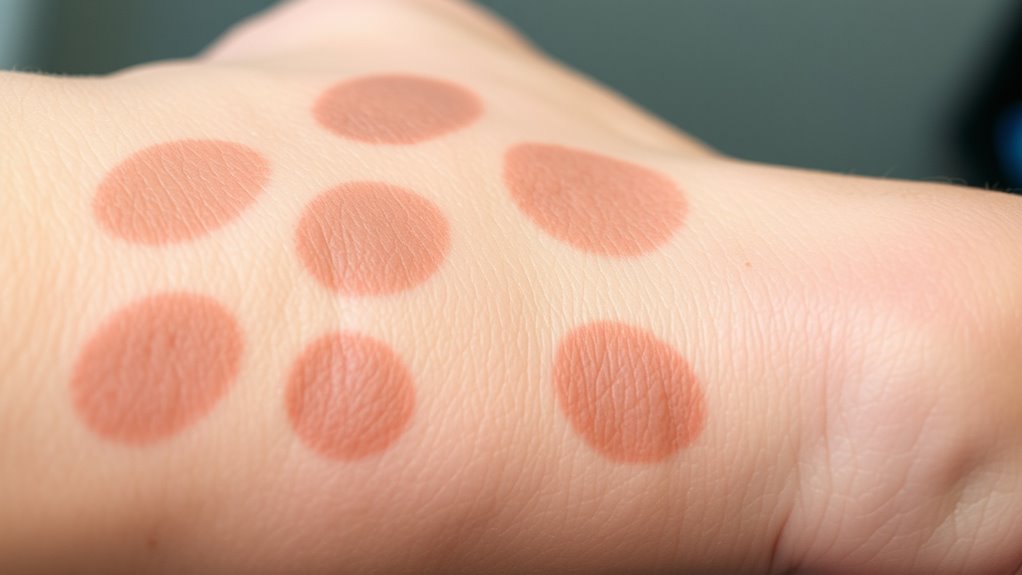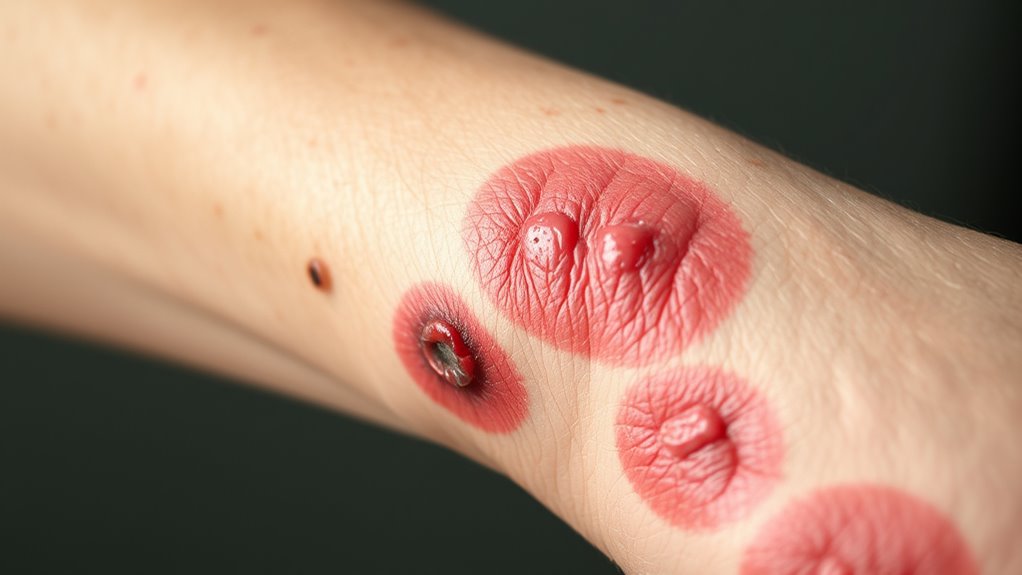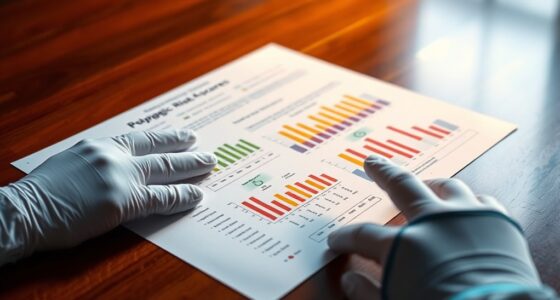If you’re noticing persistent dryness and itching, dark patches, or skin that thickens or becomes rough, these could be early signs of diabetic skin issues. You might also see wounds or sores that won’t heal, sudden rashes, or skin discoloration on your neck, armpits, or groin. Keep an eye out for changes, as early detection helps prevent problems from worsening. Learning more can help you better understand how to protect your skin health.
Key Takeaways
- Persistent dryness and itching on skin, especially on legs, arms, or hands, may indicate diabetic skin issues.
- Darkened, thickened, or velvety patches on neck, armpits, or groin are early signs of skin changes related to high blood sugar.
- Non-healing sores, redness, swelling, or pus suggest infections or skin damage that require prompt medical attention.
- Thickened, rough, or leathery skin areas, often on lower legs or feet, can signal circulation or nerve problems.
- Sudden rashes, rapid skin changes, or new skin lesions accompanied by itching or burning should be evaluated early.
Recognizing Persistent Dryness and Itching

Persistent dryness and itching are common signs of diabetic skin issues that you shouldn’t ignore. If your skin feels unusually rough, flaky, or tight, it could be a sign that your blood sugar levels are affecting your skin’s ability to retain moisture. You might notice this dryness on your legs, arms, or hands. The itching often accompanies the dryness, causing discomfort and making you prone to scratching. Scratching can lead to skin cracks or infections, worsening the problem. Keep an eye on how your skin responds, especially if you experience persistent dryness despite using moisturizers. Addressing these symptoms early can help prevent more serious skin complications related to diabetes. Proper skin care and managing blood sugar levels are key to reducing dryness and itchiness. Monitoring skin health can help catch issues early and prevent complications.
Noticing Unusual Skin Discoloration or Patches

Unusual skin discoloration or patches can be early signs that your diabetes is affecting your skin. You might notice darkened areas, often on your neck, armpits, or groin, which appear as patches of thickened, velvety skin. These changes happen because high blood sugar levels can cause your skin cells to produce more pigment or lead to increased skin cell growth. The patches may feel rough or look shiny, signaling insulin resistance or prediabetes. Pay attention if you see these discolorations, especially if they develop suddenly or worsen over time. Recognizing these early signs can prompt you to seek medical advice and manage your blood sugar levels more effectively, helping prevent further skin complications associated with diabetes. Skin changes are often linked to underlying hormonal or metabolic issues that require medical attention.
Identifying Skin Infections and Sores That Don’t Heal

When skin discoloration or patches appear, they can sometimes be accompanied by infections or sores that refuse to heal. You might notice a sore that stays the same or gets worse over time, despite cleaning and care. Watch for signs like increased redness, swelling, warmth, or pus. These symptoms indicate an infection that needs prompt attention. If you see a wound that won’t close or heal after a few days, it’s a red flag. It’s also common to feel pain or tenderness around the area. Early detection is vital to prevent complications. Incorporating self-reflection can help you monitor changes in your skin and recognize early warning signs more effectively.
Watching for Thickened or Hardened Skin Areas

Thickened or hardened skin areas are common signs of diabetic skin changes that require your attention. These patches often feel rough, raised, or leathery and can develop on your lower legs, feet, or other parts of your body. They may be painless but could signal underlying issues like poor circulation or nerve damage. Keep an eye out for areas that become noticeably thicker or tougher over time. If you notice any skin that feels different or looks abnormal, don’t ignore it. Regularly inspecting your skin helps catch these changes early. Color accuracy and proper lighting can also affect how well you recognize these skin changes. Promptly consult your healthcare provider if you see thickened or hardened patches. Addressing these signs early can prevent further skin complications and improve your overall diabetic management.
Monitoring for Rashes or Sudden Skin Changes

After noticing thickened or hardened skin patches, staying alert for other changes is important. Rashes or sudden skin changes can signal underlying issues that need attention. Keep an eye out for redness, swelling, or unusual bumps that appear quickly. These signs might be subtle at first but can worsen if ignored. Monitoring regularly helps catch problems early and prevents complications. Additionally, being aware of privacy and cookie usage on health-related websites can help you understand how your data is protected while seeking information. Here are some things to watch for: – Rapidly spreading or changing rashes – Unusual discoloration or dark patches – Blisters or open sores that won’t heal – Itching, burning, or increased skin sensitivity If you notice any of these, contact your healthcare provider promptly. Early detection makes managing skin issues easier and reduces the risk of infections. Stay vigilant, and don’t ignore sudden or unfamiliar skin changes.
Frequently Asked Questions
Can Skin Issues Indicate Diabetes Before Blood Sugar Symptoms Appear?
Skin issues can sometimes be early indicators of diabetes before blood sugar symptoms show up. You might notice darkened patches, dry or itchy skin, or infections that heal slowly. These signs happen because high blood sugar affects your skin’s health and immune response. If you observe these changes, it’s a good idea to check with your healthcare provider. Early detection can help you manage diabetes more effectively and prevent complications.
How Can I Differentiate Between Diabetic Skin Problems and Other Skin Conditions?
Imagine your skin throwing a tantrum—redness, dryness, or strange patches—like a toddler in a toy store. You wonder if it’s diabetes or just a rebellious skin condition. To tell them apart, look for symptoms like persistent dryness, frequent infections, or slow healing wounds, which are more common in diabetes. Consult a healthcare professional for accurate diagnosis, because your skin isn’t the best detective on its own.
Are There Specific Skin Areas More Prone to Diabetic-Related Issues?
Certain skin areas are more prone to diabetic-related issues, especially your lower legs, feet, and hands. You might notice dryness, cracks, or infections in these regions because poor blood flow and nerve damage from diabetes affect healing and sensation. Keep an eye on these areas for early signs, and if you notice unusual changes like discoloration, sores, or persistent dryness, consult your healthcare provider promptly to prevent complications.
What Preventive Measures Can Reduce Early Skin Complications in Diabetes?
You want to prevent early skin complications in diabetes? It’s like trying to guard a treasure chest from endless invaders! Keep your skin clean and dry, moisturize regularly, and check for tiny cuts or spots daily. Wear comfortable, well-fitting shoes, control your blood sugar levels, and stay hydrated. These simple acts create a powerful barrier, stopping skin problems before they even start. Stay vigilant, and your skin will thank you!
When Should I Consult a Healthcare Professional About Skin Changes?
If you notice any skin changes like persistent redness, swelling, unusual dryness, or sores that won’t heal, you should see a healthcare professional promptly. Don’t ignore small issues, especially if they worsen or don’t improve with basic care. Early consultation helps prevent complications. Trust your instincts—if something feels different or uncomfortable, it’s better to get checked out sooner rather than later. Your health and skin’s well-being matter.
Conclusion
By staying alert to these early signs, you’re like a vigilant gardener tending to your skin’s delicate garden. Catching dryness, discoloration, or sores early is like spotting a weed before it spreads, allowing you to nurture your health instead of battling unchecked issues. Remember, your skin’s signals are whispers from within—listen closely, and you’ll keep your body’s vibrant landscape thriving and resilient against diabetic skin troubles.









